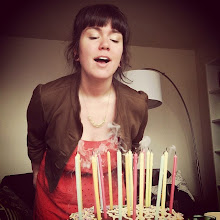
The kitchen at the Marketplace.

A group of students from Iowa State and University of Nebraska were there that day to learn about the Marketplace and have a presentation on sustainable agriculture. The ladies of the shop served lunch.

Four out of the five women were Pinklemans, so the shop really is a family affair.

This shirt says it all. Eat. Farm. Sleep.

This is Richard Pinkleman, the corn, hog, and cattle farmer we profiled. All of the corn he grows goes to his livestock. While he is very anti tax and government involvement, he recently began taking subsidies due to his son's urging.

Mary Rose in her office, the kitchen.

The Pinklemans harvest a large portion of their corn with the husks still on it in order to make silage to feed to their livestock. This was the first corn we had seen harvested still on the cob.

Richard in the hog hoop barn

Feeding the hogs

Richard in the sow barn.

Richard and Mary Rose's son, Doug. The Pinkleman's have five children, 4 boys and 1 girl, and Doug is the son who has returned to the homestead to farm.

Doug does a lot more of the business side of things and his ability to adapt to newer farm procedures and understand technology has helped keep the farm afloat as the farming industry moves farther away from the family farm and further in the direction of a corporation.

Richard fixing a part in the shop. They do almost all of their own repairs on the different machines they have, which helps save a lot of money and time.

The family dog, Shep, in the corn bin.

Richard in the hoop barn.

Preparing feed for the hogs.

This area of northern Nebraska was hit quite hard by a hail storm a few weeks prior to our arrival and their entire crop was hailed out. Luckily the Pinkleman's had federal crop insurance and so they will receive about 80% compensation from the federal government, but loss of their entire crop will surely hurt them and others. Driving through the hailed out fields was very depressing, as they really looked like skeletons sticking up through the soil.

With Mary Rose!

We also went with Mary Rose and Doug to sell some of their cattle at the Yankton cattle auction in South Dakota. What an experience! The inside of the auction building has a display with all of the brands of the different farmers that sell at that auction house. Above is the Pinkleman brand.

A view of the cattle yard on the outside of the auction house. The cows sit here before they are sent to slaughter.

The inside of the auction house where cows come out into the ring to be sold. Different meat buyers sit in the stands and bid on the different cows depending on their weight, build, and health.

A buyer's view.

This little boy and his brother stood on the edge of the ring in order to hit the cattle to keep them away from the edges of the pen.

Meat buyers at the auction house.
From St. James we headed down to Randolph, NE where we spent a few days with Mike Korth. Mike is a rather large single-family farmer and involved heavily on the policy side of the farming industry.

Mike and his mechanic at the John Deer dealership.

Mike is constantly talking on his bluetooth telephone. He is the epitome of businessman and farmer in one.

Mike on the inside of a combine.

The view from inside a combine.


The entire time we were there Mike was building a new shop on his property. Although he never went to college, Mike knows how to build buildings from the ground up. Watching him on the property with the ten men he employed was kind of like a maestro directing an orchestra. He was right in the middle of everything, barking orders left and right.

Olaf, the giant puppy, likes to ride on the back of the four-wheeler.

We spent a day with Mike at a farm bureau meeting in Kearney, NE. It was quite eye-opening for us, as we got to see the perspective of a big organization tied to the farming industry.

We also stopped off to pick up some sweet corn at the Daniels farm on the way back from Kearney. They employed a number of Mexican labourers and here they are submerging the sweet corn in cold water so that it stays sweet while it travels by semis to the supermarket.

Mike's grandfather began farming corn when he moved to Nebraska from Germany. The original family plot has now turned into a cattle feedlot and Mike farmers a few miles down the road. The above photo is the feedlot at night.

We got to write our names in the cement of the new building on Mike's property

The cats on Mike's farm had just had kittens and they were the cutest thing in the world. Finally some animals on a farm that we could play with!





















